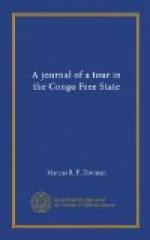I determined therefore, to read the various books and reports written against the Congo—whether the writers had ever been in the country or not—then to question the officials who had worked there, and finally to see the actual condition of affairs for myself.
We tumbled about in The Bay of Biscay a little and the motion did not much aid the digestion of the contents of histories and blue and white books. A welcome break was therefore made when we reached Teneriffe on June 29th. It is early afternoon and the view of Santa Crus from the sea is very beautiful. In the foreground is ultra-marine coloured water; on shore, bright yellow houses with red roofs dotted among palms and other foliage of vivid green, and behind all, frowns the great grey mountain 12,000 feet high. The hills stretching up from the sea are in many cases terraced for gardens and vineyards and a new hotel stands out prominently on one side. It is a glorious picture, but if the eye is delighted as the boat approaches the shore, the nose is offended immediately on landing. Streets, houses and people near the harbour are dirty and odoriferous and as the shops are all shut for a saint’s day, the town looks dismal in spite of the bright sun.
After changing some money at the shop of a jew who gave us the wrong amount and looked injured when we insisted upon the right, we took an open carriage and drove to the Cathedral. The building is not imposing from the outside, but is highly gilded within where is the famous Holy Cross which gives the town its name. There are also many wax figures representing saints, mostly dressed in the costume of the seventeenth century and enclosed in glass cases. The boy who acted as our guide having discovered our nationality, pointed out with great glee English organ, English clock. and finally with satirical humour—probably unconscious—English flags. These flags are those lost by Nelson at the siege of Santa Crus where he lost his arm and a good story is told about them. An ambitious British middy stole them from the Cathedral and was very disappointed, when instead of being at once promoted, he was forced to apologize and restore them.
We next drive up a broad, fairly well kept, boulevard to the Bull Ring situated in an open space behind the town. A woman conducts us into the ring and shows us the stables in which the infuriated beasts are kept before they are asked to shed their blood for the idle amusement of the spectators. On the walls are many names which look like British, and the guide is quite astonished when we refuse to add ours to their number.
Commandant Arnold here takes on board six camels, for it is hoped these ships of the desert will also sail equally well in the forest. The experiment is at any rate not expensive, for they only cost L16 each and will carry several hundred pounds weight of baggage.




